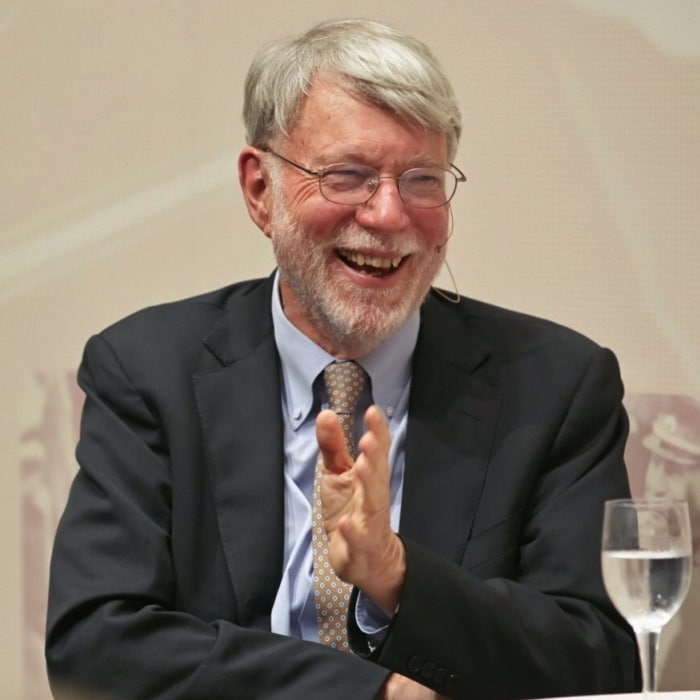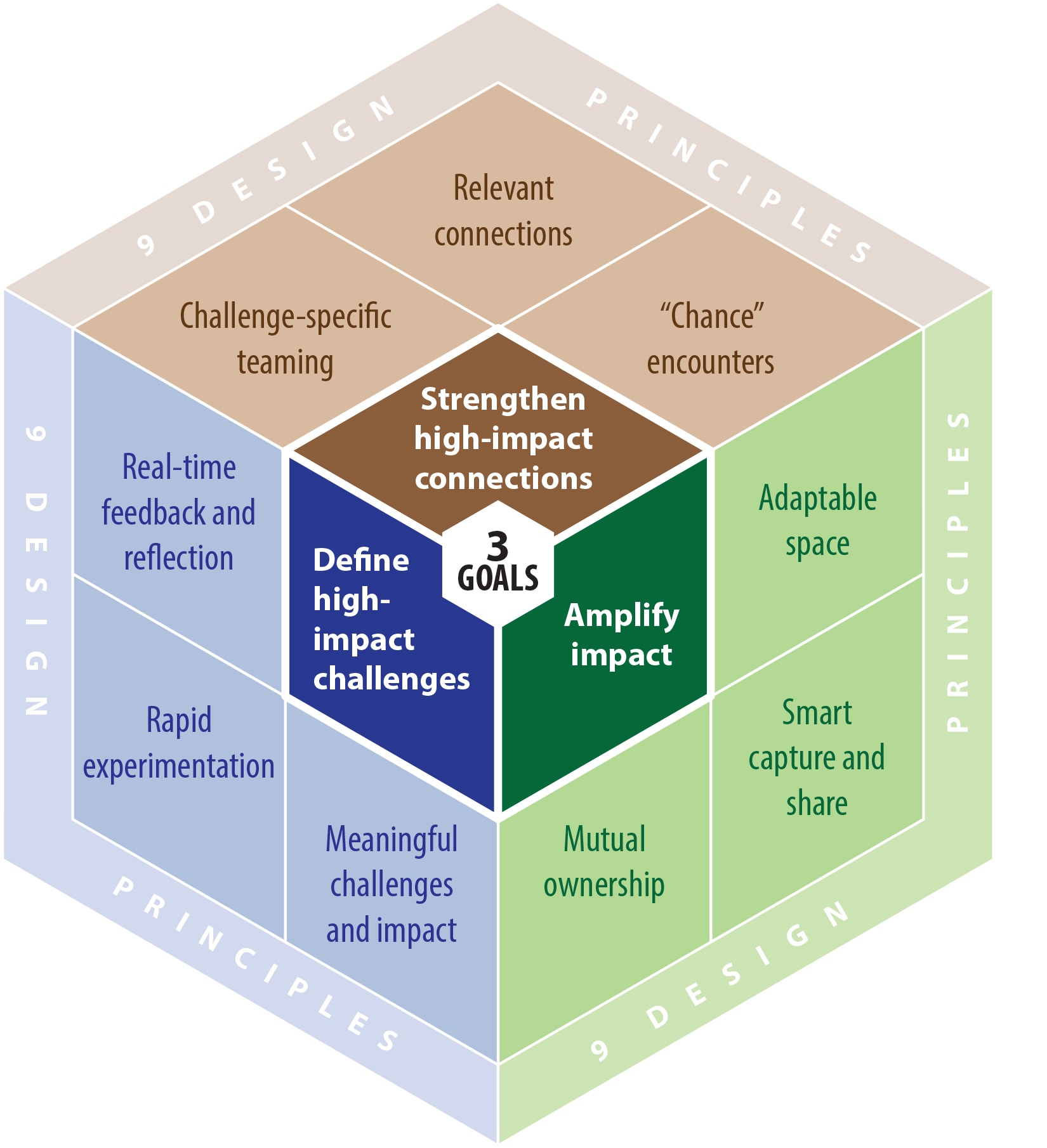Work environment redesign has been saved

Work environment redesign Accelerating talent development and performance improvement
04 June 2013
The way the workplace is constructed—physically, virtually, and managerially—can have a critical impact on employee productivity, passion, and innovation.
Executive Summary
In the face of increasing competition and declining return on assets, companies often turn to short-term, one-time initiatives that (temporarily) improve their bottom lines. While tactics such as cost-cutting may offer temporary relief, they don’t constitute a long-term strategy. We studied more than 75 companies to determine the key strategic operations differentiator and determined that to address increasing performance pressure, companies need to tap into the only resource with unlimited potential—their talent. On-the-job learning and talent development provide an effective and sustainable way to accelerate performance improvement at individual, team, organization, and ecosystem levels.
Explore the work environment redesign case studies (interactive)
Through our research of more than 75 companies varying in size, maturity, and industry, we have concluded that redesigning the work environment will be key to achieving sustainable business performance improvement in the future. We have a significant opportunity to apply design thinking and methodologies to the work environment, defined as the holistic integration of physical environment, virtual environment, and management systems. The work environment needs to be redesigned with three goals in mind to foster talent development and achieve performance improvement:
Goal 1—Define high-impact challenges: Help workers and teams to focus on areas of highest business impact, learning, and sustainable improvement
Goal 2—Strengthen high-impact connections: Enable workers to connect with people who matter, both inside and outside the organization
Goal 3—Amplify impact: Augment worker impact with the right infrastructure
Each goal can be achieved by following a set of design principles. The comprehensive set of design principles, detailed further in this paper, is summarized below (see figure 1).
Figure 1. Three goals and nine design principles
This report contains three sections. First, the opportunities and imperatives section defines the driving factors behind our chosen research topic, as well as some limitations of today’s prevailing view on talent. Next, design principles for performance improvement provides detailed descriptions and case studies for nine design principles to accelerate talent development. Lastly, implementing work environment redesign discusses how companies can start experimenting with, and eventually scale, the design principles prescribed in this paper.
Opportunities and imperatives
Talent development is often viewed as more art than science. The relationship between raw talent, training, and results delivered is seen as operating within a black box: crucial, but only loosely understood. To better understand this linkage, we can take a closer look at the workplace. How we configure the work environment—literally and figuratively—affects the degree to which we realize the potential of the talent brought into the organization.
One clear example of a company encouraging the internalization of talent development to the employees is Toyota Motor Corporation (Toyota). It provides its employees with a deep sense of ownership for the manufacturing process through the Toyota Production System (TPS). Employees at Toyota have a deep sense of ownership of the manufacturing process and learn that improving performance is paramount, even when it temporarily stops production. One of the key components of TPS is the Andon cord, a rope on the manufacturing line attached to a series of lights. When any worker pulls the Andon cord, the entire assembly line stops immediately, lights flash, and all nearby workers work together to resolve the problem. Production does not resume until the issue is resolved. The Andon cord gets pulled hundreds of times a day for quality and safety issues. After pulling the cord, workers celebrate the focus on improving performance.1
Toyota and TPS have been widely studied by the corporate and academic world as examples of sustained performance. Toyota has outperformed its peers in terms of revenue for more than 10 years,2 and in 2012, the company generated approximately $226 billion in sales. In early 2013, Toyota remained at the top of the annual US consumer survey on brand perception, which measures quality, safety, value, performance, design, technology, and green attributes.3 Toyota’s success is not, however, driven solely by dedication to specific practices, but also by a work environment that engages workers in improving the system and, in doing so, ensures continual development.
Andon cords are just one example of the broader management practices that Toyota uses to support on-the-job learning. Steven J. Spear, who has extensively studied TPS, says Toyota enables “a series of nested, ongoing experiments, whether the work is as routine as installing seats in cars or as complex, idiosyncratic, and large-scale as designing and launching a new model or factory.”4 The result is that every worker constantly looks for opportunities to make improvements in their production environments. The Toyota work environment is an example of a talent development platform: an environment that engages employees to solve problems on the job so that their abilities are developed. By focusing on helping front-line employees develop through on-the-job performance improvement, Toyota has created an environment where talent at all levels of the organization can continually improve.
Reframing the talent opportunity—and challenge
The Toyota example illustrates a relatively unusual approach to talent development. Most of today’s executives recognize the growing importance of talent—they are, to perpetuate the cliché, in a “war for talent.” It is an extraordinary asset that can often make or break a business and certainly plays a key role in driving the performance of our companies. But there are several issues with how most companies approach opportunities for talent development.
First, the scope of talent is relatively narrowly defined, often referring only to “high potential” employees and knowledge workers within the four walls of the enterprise. Second, the primary focus of many executives appears to be on attracting and retaining talent. If talent development comes up at all, it is usually confined to a discussion of training programs.
Finding new and more powerful ways to develop talent is not only an attractive opportunity to create value, but is also becoming an imperative.
While traditional training programs are important, particularly when dealing with items such as compliance and merger integration, they have several shortcomings. It is difficult to train for time-intensive exception handling that occurs outside of standard, business-as-usual processes. Traditional programs also often neglect to consider the unique context and setting where skills need to be applied, and to some degree the skill sets of each worker. And because training sessions usually occur based on fixed schedules—rather than employees’ needs—much is forgotten between training and execution.

Furthermore, with the increasing pace of technological innovation, it is difficult to predict what specific skills people will need in the future. Many training programs become out of date, if not obsolete, by the time they are launched. At the same time, many executives also find themselves unable to fill high-skilled positions, and are perpetually searching for and paying a premium for employees with specific skill sets. Unfortunately, the value of these or any other specific skills is depreciating increasingly quickly as well. For example, the skills that graduates acquire during four years of college have an expected shelf life of only five years.5
Finding new and more powerful ways to develop talent is not only an attractive opportunity to create value, but is also becoming an imperative. Given long-term shifts in the global economy, performance pressure is mounting. Structural shifts in the business landscape, such as advances in digital infrastructure and liberalization of public policy on a global scale, are tipping the balance of power from companies to individuals. Information asymmetries that favored companies are being eroded, and consumers are benefiting from more product and service choices and low switching costs. Growing international competition is driving down margins. Additionally, high-skilled workers are finding that they can demand higher compensation for their work. As a result, companies find themselves squeezed from all sides, and consequently, the performance of US public companies has steadily declined over the past 45 years. The return on assets (ROA) for US public companies is particularly telling; since 1965, ROA has fallen by 75 percent.6 However, rather than focusing on the implications of these long-term shifts, executives tend to react to cyclical pressures, resorting to short-term efficiency measures such as cost-cutting initiatives and layoffs.
In order to address the long-term, negative performance trend, companies need a holistic redesign of the work environment to accelerate learning and performance improvement on the job. While physical assets and intellectual property rapidly lose value, workers are the only assets that possess the infinite ability to constantly reinvent themselves and continuously push the limits of performance improvement. The bottom line is that companies need to redefine themselves as platforms for talent development, creating environments where talent can develop and learn more rapidly than anywhere else.
To show how companies can create on-the-job work environments to improve performance, we researched over 75 companies of varying sizes, maturity levels, and industries, exploring differing work environments for front-line workers through management. We considered both the physical and virtual aspects of the modern workplace, as well as the management systems that govern them. We have taken the holistic problem-solving approach pioneered by design thinking, and have sought to extend it beyond product or service design, or even user experience design, to apply it systematically to the entire work experience. Additionally, we look at technologies that have become more accessible in the past few years, such as social media, big data, and cloud computing, and their role in facilitating performance improvement.
Our research suggests nine design principles that serve as the foundation for a broad approach to on-the-job talent development and learning. By shifting priorities toward enabling on-the-job performance improvement and learning—and by providing the tools, infrastructures, and connections workers need to progress to the next level of performance—companies may for the first time have an opportunity to move from diminishing returns to increasing returns, where everyone learns faster as more and more participants are engaged.
Although we sought to understand the work environment holistically, there are several related topics that are either widely covered in the public arena or prerequisites for companies to perform with basic effectiveness. In this paper, we do not discuss onboarding or recruiting, business strategy, the effects of leadership styles, or compensation packages. We have excluded them to focus on the broader study of companies using work environment redesign to become talent development platforms.
Participants in talent development platforms
Performance improvement occurs at various levels of the organization, ultimately driven by groups of people working together to solve new challenges. As we researched different companies, we focused on four levels of performance improvement. While all four play important roles, the largely untapped potential lies in more effectively organizing teams and connecting them to broader ecosystems to more effectively tap into and build upon distributed tacit knowledge. These levels are:
Individual: While collaboration is key to performance improvement, engaging workers at the individual level is a crucial step, because each employee has distinct needs, motivations, and interests.
Team: Teams or local work groups are the fundamental unit of performance improvement within an organization. Interactions within these long-standing work groups foster trust-based relationships that are essential for transference of not only specific information, but also, more importantly, tacit knowledge that cannot be easily written down or explained (such as fine-tuning an engine). Tacit knowledge is the basis for high-value skills; it makes employees more valuable to organizations. Additionally, the deep relationships that teams share create a productive environment for combining talents to push performance to levels greater than the sum of each individual’s part.
Organization: Fluidity within the organization helps individuals and teams connect with other teams in ways that enable improvements, techniques, and leading practices to spread across the organization. This requires breaking down the silos of traditional organizational structures, but results in significant improvements in performance.
Ecosystem: Former Sun Microsystems CEO Bill Joy said, “No matter who you are, most of the smartest people work for someone else.”7 Many innovations and leading practices reside with other organizations. To maximize opportunities for talent development, organizations must think of themselves as operating within the broader context of their business ecosystem and actively reach past the four walls of their institution for ecosystem collaboration. Many executives view external collaboration as an intellectual property or brand risk—and these are valid concerns—but companies that design work environments to allow workers to easily connect and build relationships across the ecosystem will have more access to greater depth and breadth of brainpower.
Design principles for performance improvement
The three goals
Most employees today are not passionate about their work.8 Passion, in this context, is characterized by two key dispositions, or orientations toward action: questing and connecting. A questing disposition seeks out and is excited by new challenges that test personal capabilities and push new levels of performance. A connecting disposition seeks to connect with and learn from others who can help achieve improvement. When these two dispositions come together, heightened performance occurs. To drive performance improvement, companies should focus work environment design on catalyzing and amplifying passion among professionals. Our research suggests three work environment design goals to that end:
Goal 1—Define high-impact challenges: Help workers and teams focus on areas of highest business impact, learning, and sustainable improvement
Organizational ability improves when workers and teams strive to achieve more and higher-quality work. Work environments should help workers identify new challenges and focus their attention on the challenges most likely to significantly impact the performance of the firm and its ecosystem. As they work through these challenges, a rapid experimentation approach can enable workers to quickly iterate, receive immediate feedback, and reflect on lessons learned to quickly apply them to future iterations. Done right, this can help workers cultivate a questing disposition.
Goal 2—Strengthen high-impact connections: Enable workers to connect with people who can help them achieve new levels of performance, both inside and outside the organization
Most work environments have rigid organizational structures that silo workers and impede collaboration. Work environments instead should identify similarities, interests, and capabilities to aid team formation, and enable relationships beyond team structures. Additionally, companies should connect employees with outside people with relevant expertise. Accessing rich, diverse flows of knowledge helps teams improve even faster. This design goal can help to foster a connecting disposition as workers discover that only modest effort is required to encounter and interact with relevant people, wherever they are.
Goal 3—Amplify impact: Augment worker impact with the right infrastructure
Many individuals think of work environments as simply the traditional physical space where employees show up Monday through Friday. The problem with this perspective is that it focuses on the environment where work happens rather than how the environment affects work. A broader view of the work environment includes the physical, virtual, and management infrastructure that amplifies the efforts of workers. On all of these dimensions, there are opportunities to provide workers with platforms and tools that can help them achieve ever higher performance levels. By amplifying impact, this design goal can reinforce the development of questing and connecting dispositions as workers see that their efforts produce greater-than-expected results.
Design principles
The nine design principles and three goals for performance improvement we suggest (summarized in figure 2) are meant to be guideposts, rather than detailed prescriptions. Every organization is unique, and will need to internalize, evaluate, and implement these design principles differently.
Figure 2. Three goals and nine design principles
While applying principles individually will increase performance improvement, companies have the potential to significantly amplify performance improvement with comprehensive application of these design principles. Following is a detailed description of each design principle, including case studies.
Goal 1: Define high-impact challenges
To address the first goal, three design principles are particularly effective. Meaningful challenges and impact focuses on identifying and pursuing the right challenges, while rapid experimentation and real-time feedback and reflection provide guidance on how best to convert challenges into performance improvement and learning.
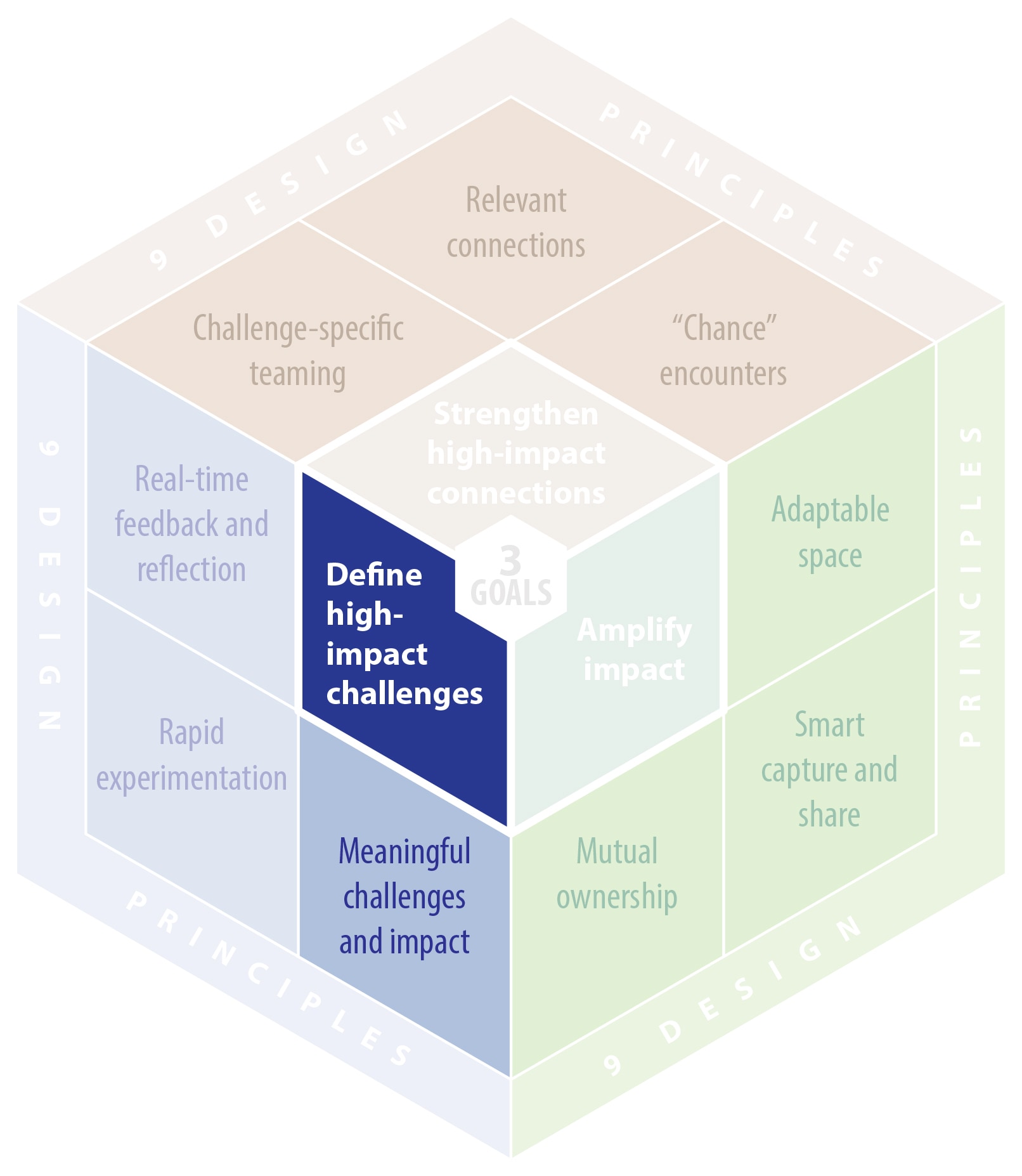 Design principle #1: Meaningful challenges and impact
Design principle #1: Meaningful challenges and impact
Environment offers meaningful challenges and supporting resources that maximize performance impact and stretch individuals’ abilities.
Challenges in the workplace are defined as any project, role, or initiative a worker or team takes on. Challenges are meaningful when employees understand how their work impacts the broader organization and if the challenge stretches workers’ abilities. An environment that consistently provides these types of challenges can energize and excite workers, and motivate them to perform at a higher level. To create such an environment, companies should leverage platforms that make impact transparent and establish processes for workers to “level up” to more difficult challenges.
There are two important reasons why workers should understand how they affect the overall organization. First, employees and teams should be clear on how their current activities impact organizational performance. Global automotive manufacturer Toyota is a good example of making organizational impact transparent. As described earlier in this report, assembly line workers pull an Andon cord when they discover a problem. This triggers a stoppage of the entire assembly line and brings exclusive attention to the problem in that location. This process makes the use of Andon cords meaningful for each employee, as they see how it (and therefore they) can trigger an improvement to the overall manufacturing process, impacting the company as a whole. Second, companies need to help workers identify where the biggest organizational pain points are so they may pursue the most impactful challenges. For this to work, companies’ front-line, operating, and financial metrics—and how they affect one another—must be transparent. This will help workers understand how to maximize their impact on the organization.
Companies can offer workers challenges that continuously stretch their abilities, motivating their development. Dave Hoover, a partner at Obtiva, a small software consultancy acquired by Groupon in 2011, created an apprenticeship program that stimulates individual performance improvement. As part of a core team, beginners work directly in the trenches and receive small challenges from their mentors. As they improve, challenges become increasingly difficult, continually motivating apprentices to grow their abilities.9 These growth opportunities incite worker passion.
A similar effect can be seen in a very different work environment at oDesk, the world’s largest virtual workplace platform. oDesk’s virtual platform enables contractors to see how their peers are performing (e.g., hourly rates) and what actions or activities those peers have done to achieve that level of performance (e.g., feedback ratings, comments, certifications). This transparent virtual environment design motivates oDesk contractors to stretch themselves and improve their skills so they can eventually earn the high hourly rate their peers command.10
Work environments that can incorporate meaningful challenges into everyday work will drive worker motivations, leading to new performance levels.
Moving past the status quo
Companies often fail to fully utilize challenges as motivational mechanisms to improve worker abilities. Rarely do organizations help employees understand how their everyday tasks roll up and influence the performance of their department, business unit, organization, or ecosystem. Even more rarely do companies proactively help workers identify where their time and effort could be better spent to achieve grander impact. To stretch individuals, some organizations experiment with rotational programs, but many such programs simply move workers between departments without focusing on “leveling up” abilities. Also, many rotational programs are reserved for management-level workers.
Currently, many managers do not make time for articulating how individual contributions benefit their departments and the organization as a whole—they either don’t think it is important, are too busy, or may not themselves understand how individual contributions truly roll up to impact overall performance. To enact these changes, leadership could model desired behaviors, and set the expectation that everyone should understand how individual tasks impact the company.
Additionally, companies must become comfortable with the notion that workers moving to unfamiliar roles initially may not be as productive while they learn new skills. Traditionally, companies believe that the most effective way to create value is to hire a specific expert into a specific role and have that person continually produce in a tried-and-true way. However, firms should realize that time spent exploring challenges is not a cost, but rather an investment in a stronger future workforce.
Anixter International
Anixter International is a leading global supplier of communications infrastructure. Over 15 years ago, Anixter sold roughly $1 billion annually and needed to grow in adjacent markets and new countries. The sales force was organized so each salesperson was comfortable selling a narrow band of similar products, but lacked the knowledge to cross-sell other categories. The inside sales team looked to Michael Hugos, a game design specialist, to create a sales system that challenged salespeople to become knowledgeable in entirely new product lines. As salespeople became more comfortable selling new products, they would be stretched again by having the opportunity to sell yet another unfamiliar product. These challenges energized the sales team—participants enjoyed the challenges, citing it as “fun” and a way to be “much more adventurous”11 while also increasing their commissions. This accelerated learning model helped Anixter International’s product and market growth, enabling them to achieve $6 billion in sales today.
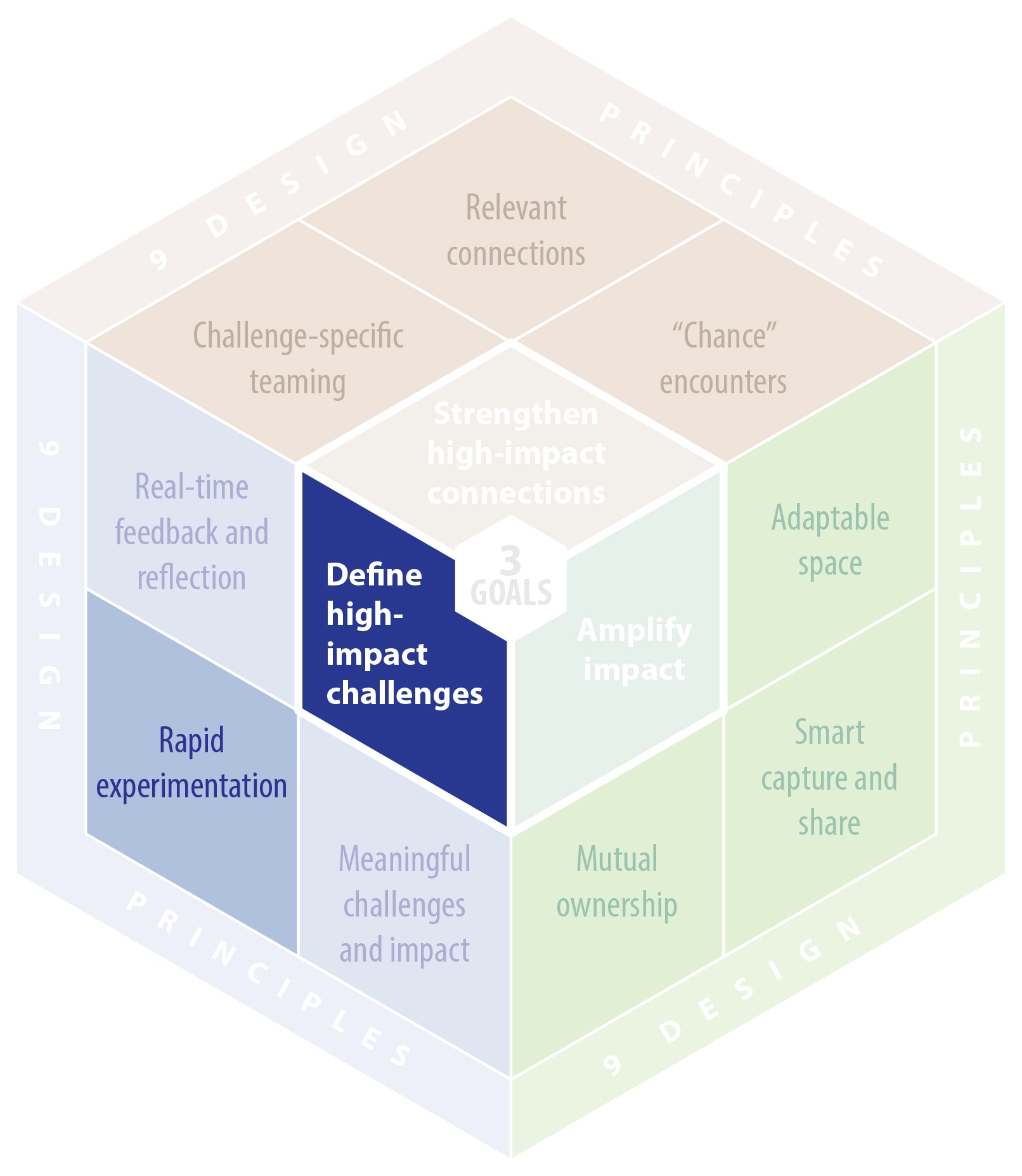 Design principle #2: Rapid experimentation
Design principle #2: Rapid experimentation
Environment provides platforms and incentives for participants to engage in rapid, low-risk prototyping to improve new ideas and to succeed or fail quickly and inexpensively.
Rapid experimentation is a methodology for conducting iterative and quick pilot studies to inform project direction. During this process, simple prototypes are developed and shared with customers, partners, and other ecosystem players to obtain feedback. This feedback is quickly incorporated and the project is reviewed repeatedly until it is complete. Quick failures are necessary for long-term success. By experimenting rapidly, ideas are tested quickly without a significant commitment of time and resources. In a world of constant disruption, rapid experimentation effectively develops products and processes that improve company performance. To facilitate rapid experimentation, companies should build experimentation platforms and ensure modularity of processes and products.
First, companies should build and support experimentation platforms. An experimentation platform is a combination of processes, tools, and management practices designed to facilitate rapid experimentation to compress cycle times and reduce risk of failure. Key components for building experimentation platforms are physical or virtual spaces used by project teams to share feedback with ecosystem players; tools that enable prototyping and feedback collection; compressed time between iterations; and management support. Intuit, a financial and tax software and services company, incorporates experimentation platforms into its day-to-day operations. This rapid prototyping approach was first embraced by the company in 2007 in the face of decreasing measures of customer recommendations (net promoter scores) for its product. Intuit was able to reinvent itself through the Design for Delight (D4D) initiative, which became the foundation for the company’s experimentation culture. As a part of the initiative, a new team of 10 innovation catalysts, or coaches, was created to help front-line managers develop prototypes, design experiments, and gain insights from customers. D4D, which is now embedded in the entire Intuit organization, consists of three principles:12
Deep customer empathy: Know customers better than they know themselves. Employees spend time observing customers in their offices and homes to identify pain points that Intuit and its partners can solve.
Go broad to go narrow: The first idea is rarely the best. Employees brainstorm as many potential solutions as possible and then choose the one or two that will most delight the customer, as opposed to the idea that will be fastest to implement.
Rapid experiments with customers: Companies can never learn too often or too early with customers. Employees create functional prototypes that allow them to watch how people use their products, and then iterate to address unmet needs and improve performance.
The D4D process serves as an experimentation platform for Intuit’s product development and leads to offerings that address unmet customer needs. In one instance, Intuit’s tax group tested a mobile app idea through the D4D process detailed above. After studying dozens of smartphone users, they quickly realized that Millennials’ top desire in their tax experience is simplicity. The team tested the product directly with customers on Friday, collated customer feedback on Monday, brainstormed solutions on Tuesday, designed on Wednesday, coded by Thursday, and was ready to receive customers again the next Friday. This group’s product, SnapTax, holds a 4.5 rating in the Apple and Android stores and commands a Net Promoter Score in the high 80s.13
The SnapTax example illustrates how Intuit’s experimentation platform applies to the development of a customer product. A similar approach can be found in Intuit’s support functions as well. One innovation catalyst, who is a sales operations manager, runs experiments with her 82-person team on a biweekly cycle, demonstrating hard savings and talent benefits alike. A single experiment helped the team find $4 million in retained revenue, while internal employee engagement scores for innovation capabilities within her group went from 85 percent to 100 percent.14 The experimentation platform at Intuit helps the company delight its customers, as well as develop and engage the people who serve them—Intuit’s employees.
In addition to experimentation platforms, companies should build modularity into their process and product design. When products and processes are too tightly coupled, there is little room for experimentation, as a change in one area can cause dramatic, and sometimes unexpected, impact elsewhere. Breaking a process into independent modules allows individuals and teams to experiment with smaller pieces of work. By pre-defining the inputs and outputs of each module, experimentations within modules become less risky.
Li & Fung Limited, a Hong-Kong-based multinational company, is globally recognized as a leader in consumer goods design, development, sourcing, and distribution.15 The company operates a network of 15,000 supply partners generating about $20 billion in revenue.16 Li & Fung has been effective in creating a modular supply chain. Instead of designing a rigid and tightly scripted supply chain, Li & Fung breaks down processes into small pieces and focuses only on specifying the requirements for hand-offs between these pieces. Each supplier is responsible for determining the best way to achieve the specifications for the process step assigned to it. Li & Fung does not manage or control the process of getting there, only whether or not the outcomes meet specifications.17 This loosely coupled system allows each partner to innovate without impacting other players in the supply chain—as long as performance results are met at each juncture.
While Li & Fung’s supply chain is an example of modular process, DPR Construction (DPR), a building contractor and construction management company, designs modular products. When building a hospital, one project engineer noticed that the bathrooms in hospital patient rooms were arranged back to back. He postulated that dozens of these “double bathrooms” could be pre-fabricated almost entirely offsite and then slotted into the building like a puzzle piece. The innovation team agreed to invest $30,000 for a prototype to be built in Arizona (where labor was cheaper) and transported back to the construction site in California. After a few tweaks to the prototype, this new building technique became functional. This relatively small investment in rapid experimentation has the potential to save six to eight weeks in build time and labor costs, a significant amount for a multi-million dollar construction project.18
Moving past the status quo
Many companies are poorly designed for rapid experimentation, overemphasizing upfront planning and detailed process engineering. Many processes in today’s organizations are inflexible, limiting potential for easy experimentation. Rigorous stage gates require multiple approvals and comprehensive documentation. Additionally, customers and outside parties are rarely, if at all, involved until the end of the development process—when the new product is released. In non-customer-facing situations, outside parties are not regularly consulted for the process or outcomes of the effort. As a result, there is limited room for experimentation. New is viewed as dangerous, and failure is avoided at all costs.
To overcome these common barriers, leadership must communicate and model a rapid experimentation mindset by removing rigid barriers and repercussions for fast failures. Failing quickly and inexpensively should be seen as a necessary and celebrated byproduct of learning that results in increased performance for the business.
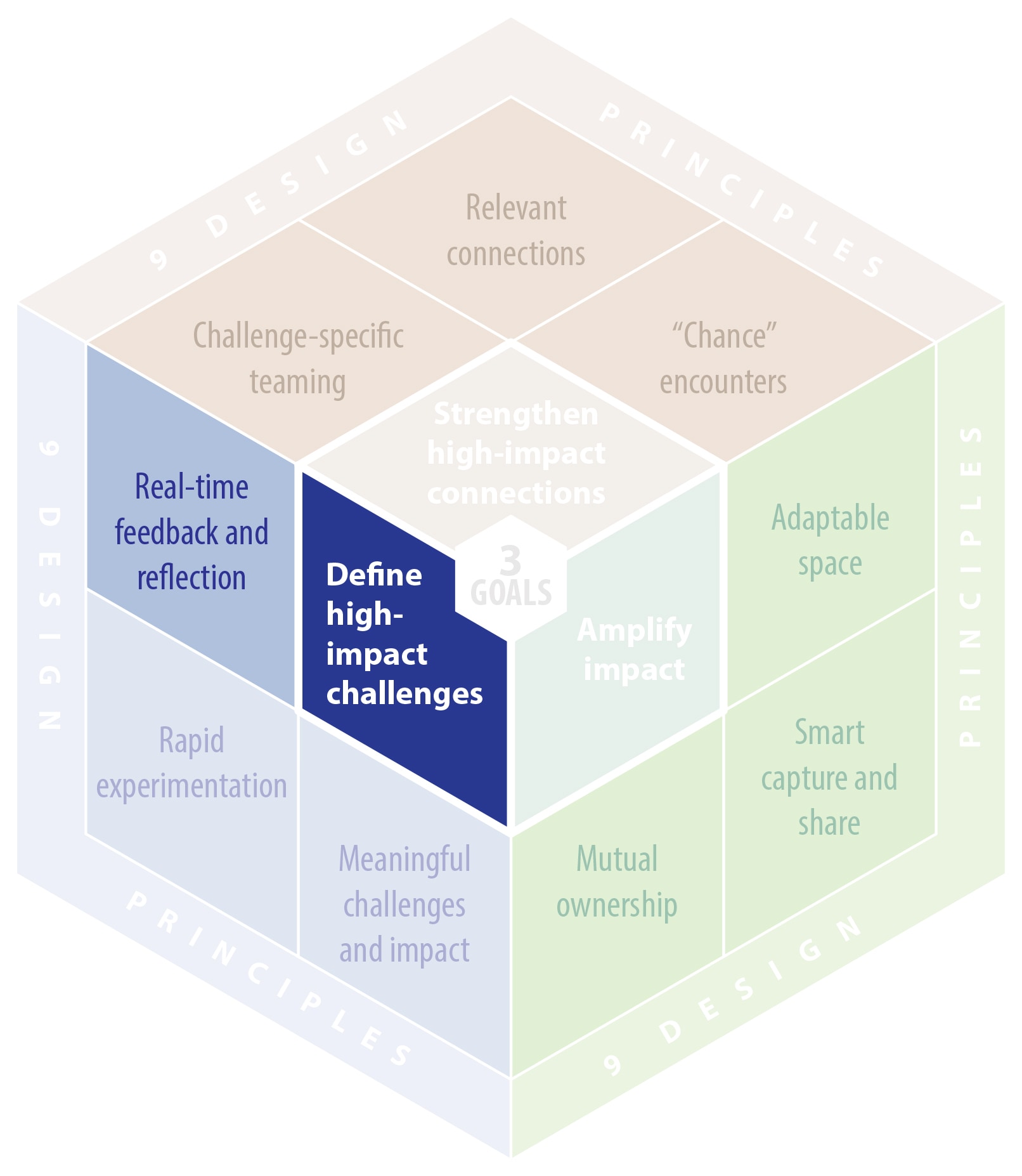 Design principle #3: Real-time feedback and reflection
Design principle #3: Real-time feedback and reflection
Environment provides ability for individuals and teams to receive rich, real-time, and context-specific performance feedback and to reflect upon it.
Real-time feedback and reflection are two of the most important methods for workers to improve their performance. Methods that encourage feedback, such as the gamification of business processes, have increased in popularity over the past several years because of the potential to motivate workers to new levels of performance.19 Real-time feedback is the most important element of gamification, according to Hugos, the gamification specialist.20 In addition to gamification trends, today’s advancements in sensors, analytics, and computing help to illuminate performance data more easily. Effective timing of feedback should amplify the quality and impact of lessons learned for both individuals and teams.
At the individual level, LiveOps, a virtual call center company, provides agents with access to live dashboards that show performance statistics immediately after a call. For example, agents can see real-time changes in their ranking among peers on numerous key performance indicators, specific to each agent’s set of clients. This helps them reflect on what they did on that particular call and their actions’ effectiveness.21
As an example of team feedback, Hugos, who is also the CIO of a distribution company, gamified a business process in 2004. This began when the new purchasing manager at a leading beverage chain, one of the distribution company’s customers, stated a goal of reducing excess inventory by at least half from the previous year. To help various parties accomplish this goal, Hugos developed feedback systems to unify previously disjointed teams. First, he created a shared pool of data with the customer’s business units and the manufacturer’s teams. Even though the network spanned thousands of retail locations, 26 distributors, and 40 manufacturers, everyone received an unprecedented level of accuracy from the supply chain data, which is refreshed in Hugos’s system every night.22 Then, in real time, teams shared feedback and discussed specific areas of inventory. The dashboards displaying this information enabled teams to more quickly propose and act on opportunities for improvement.
In addition to receiving context-specific feedback, workers need time to periodically reflect on past actions to determine how to improve. Systems and tools facilitate reflection, but leadership must also encourage reflection periods. In the US military, mission success or failure can mean the difference between life and death, making performance improvement crucially important. “After action reviews” (AARs) are a vehicle the military uses to provide real-time feedback and enhance team reflection. In an AAR, a team or platoon discusses and documents three things to debrief the mission: what was supposed to happen, what actually happened, and the reasons why the event went well or poorly. This approach ensures that reflection happens immediately and knowledge is captured for future missions and new team members. One platoon leader used rigorous AARs while deployed in Afghanistan that enabled his team to disarm 35 improvised explosive devices in a month without injury.23 By diligently completing AARs and documenting insights, the platoon was able to better navigate difficult terrain and perform more effectively.
Moving past the status quo
In most companies, feedback is gathered once or twice a year for performance reviews. Some dedicated managers might coach their team members on a real-time basis, but this requires a manager who carves time out of the day for feedback and reflection as everyone rushes to the next task. Most reflection, when it does happen, tends to be one-on-one. When teams do make time to meet for rare postmortems or debriefs, little support exists to act on newly uncovered lessons. Amy Edmonson’s research at Harvard Business School cites “the blame game” as the common issue during team debriefs; team members tend to hide failures to avoid blame, foregoing a valuable opportunity to learn from mistakes.24
Furthermore, negative feedback may lead to adoption barriers. Transparent performance data can be perceived as an unnecessary source of stress and competition when, in reality, feedback systems can be customized to show different views to different workers. Time is also a precious commodity and can be used to deprioritize reflection. With an increase in tools such as social media or big data, however, the excuse that feedback is time-intensive will become less and less relevant.
Not Your Average Joe’s
Not Your Average Joe’s is a 17-unit restaurant chain based in the Boston metro area that decided to increase real-time feedback in its work environment through software from Objective Logistics, a gamification software company. Using a platform linked to the restaurant’s point-of-sale systems, Not Your Average Joe’s customized front-line wait staff data. Besides revenue, the tool tracks additional business metrics such as average check size, customer satisfaction as measured by tips, and employee job satisfaction as measured by turnover.
Through leaderboards, Not Your Average Joe’s employees are motivated by an amiable competitive environment, as well as the knowledge that their efforts are being tracked accurately at an individual level. The tool provides real-time feedback and opportunities for learning through customized leaderboards and dashboards. Any waiter or waitress can log on to the system from any location and see how he or she ranks compared to their peers, what his or her average tip percentage is, and how much in tips he or she earned relative to the top performer from that shift. Objective Logistics predicts that companies can expect a 2-4 percent revenue increase within one month of deploying its gamification platform,25 with Not Your Average Joe’s experiencing similar results.
Goal 2: Strengthen high-impact connections
Connections between workers and people with valuable insights inside and outside the organization are created through three key design principles. Challenge-specific teaming brings people with a similar purpose together, relevant connections strives to reveal otherwise unknown sources of pertinent information, and chance encounters aims to make systematic what many believe to be “just luck.”
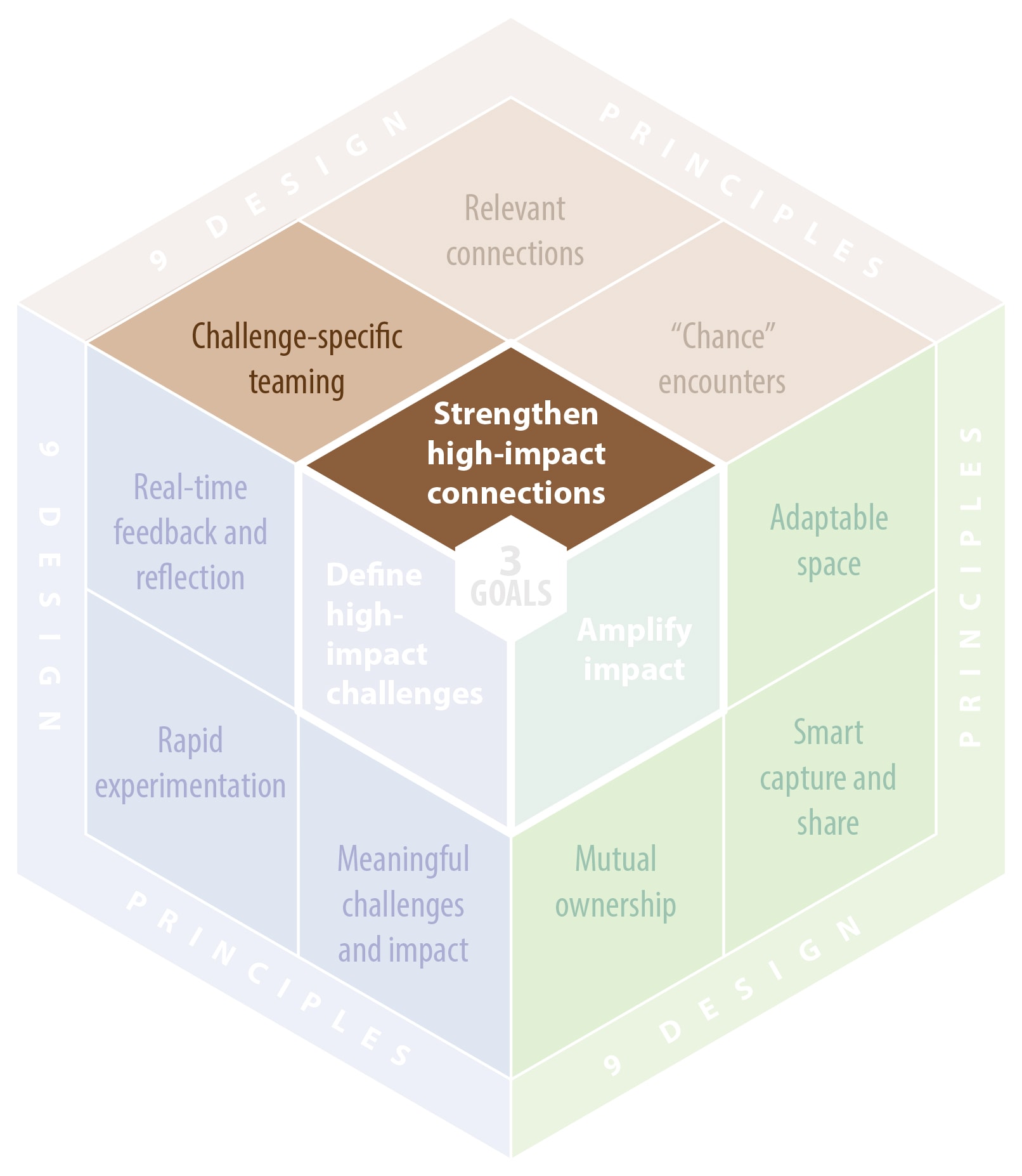 Design principle #4: Challenge-specific teaming
Design principle #4: Challenge-specific teaming
Environment enables individuals to collaborate with others in the ecosystem physically and virtually, as well as to form, dissolve, and re-form teams to quickly respond to a need or an opportunity.
Challenge-specific teaming involves forming teams for common objectives, tasks, or projects. This model allows for the most effective team members for any particular job to come together to tackle the work at hand. Additionally, as unexpected disruption increasingly becomes the status quo, it enables organizations to achieve enhanced team adaptability and collective responsiveness. The work environment should include two elements to harness challenge-specific teaming—encouragement for employees to choose their own teams based on interest, and access to teaming with ecosystem partners outside the organization.
Valve, a software start-up based in Bellevue, WA, encourages autonomous formation of teams by loosening traditional hierarchies. Without managers or reporting structures, Valve has no supervisors to dictate what employees should or should not do; employees are expected to individually direct themselves toward what is most valuable for the customer. The company encourages challenge-specific teaming, bringing individuals together based on interest and allowing individual team members to define what roles they will play and what work they will contribute. By allowing employees to “vote with their feet” to decide which teams they will join for maximum customer impact, this flat organizational structure strips away barriers between employees and customers to achieve higher performance improvement.
Goldcorp, a gold mining corporation, solved a serious business problem by partnering with teams in their ecosystem but outside their organization. In 2000, Goldcorp struggled with a mine yielding low results in Red Lake, Ontario. In addition to relying on his internal team of geological experts, CEO Rob McEwen shocked the conventional mining industry and business world by publishing over 400 megabytes of previously guarded Red Lake mine data, challenging the world to do the prospecting for Goldcorp for prizes totaling $575,000. Within weeks, over 1,000 prospectors from 50 countries worked on the “Goldcorp Challenge,” identifying over 110 targets on the Red Lake land; more than 80 percent of these targets yielded gold. Goldcorp mined more than 8 million ounces of gold following the challenge, conservatively estimating the value of the gold to be over $3 billion,26 and continues to produce gold from the Red Lake mine each year.
Goldcorp is an example of a company that was able to use challenge-specific teaming to leverage its ecosystem through an open model of innovation. They were able to turn a modest initial investment into significant financial returns. By acting as a facilitator for their ecosystems, companies can either solve specific challenges once, or obtain continuous returns by engaging the ecosystem participants in ongoing collaboration.
Moving past the status quo
Today, fluid challenge-specific teaming is not common. Leadership dictates the formation of functions, departments, and teams from the top down, with little flexibility. Organizations continue to budget for and organize their employees in functional silos, having them collaborate across functions only occasionally in “task force” assignments before employees return to their assigned, everyday roles. Additionally, some work settings, such as in-person field assignments, are inherently more difficult to transform into a teaming environment.
However, a model of flexible teaming can provide bottom-up team formation, as well as top-down guidance, to achieve higher employee engagement. Further, today’s collaboration technologies, such as video conferencing, screen-sharing applications, and co-creation tools, already provide an easy infrastructure for teaming and collaboration, particularly in virtual settings. While allowing the constant forming and re-forming of teams may seem intimidating for employers that perceive loss of management control, an adaptable teaming model and work style are worth exploring within most work settings to increase performance.
In terms of ecosystem partnerships, companies today primarily focus on customer experience and coordinating resources with suppliers and vendors, but rarely on forming teams across company boundaries to solve specific performance challenges. Companies have traditionally been fiercely protective of intellectual property and wary of “outsiders.” Increasingly, companies are finding a balance between protecting intellectual property and sharing data and information with a larger public in ways that can reap huge dividends in terms of talent and knowledge.
AT&T’s Foundry
AT&T’s Foundry is an innovation center spread across three locations that attracts external developers, venture capitalists, and other community members. The Foundry supports opportunities to use AT&T employees and ecosystem partners alike in challenge-specific teaming for improved business performance.
One AT&T development team sought to accelerate the development of new functionality for its Internet-delivered TV service, U-verse. The team looked to the Foundry for external specialists and, by accessing the list of start-up companies housed at the Foundry, recruited passionate and relevant team members whether or not they were AT&T employees. This model of challenge-specific teaming quickly matched the most effective team members to the problem, and new products and features that used to take AT&T three years to complete now take 8-9 months.27
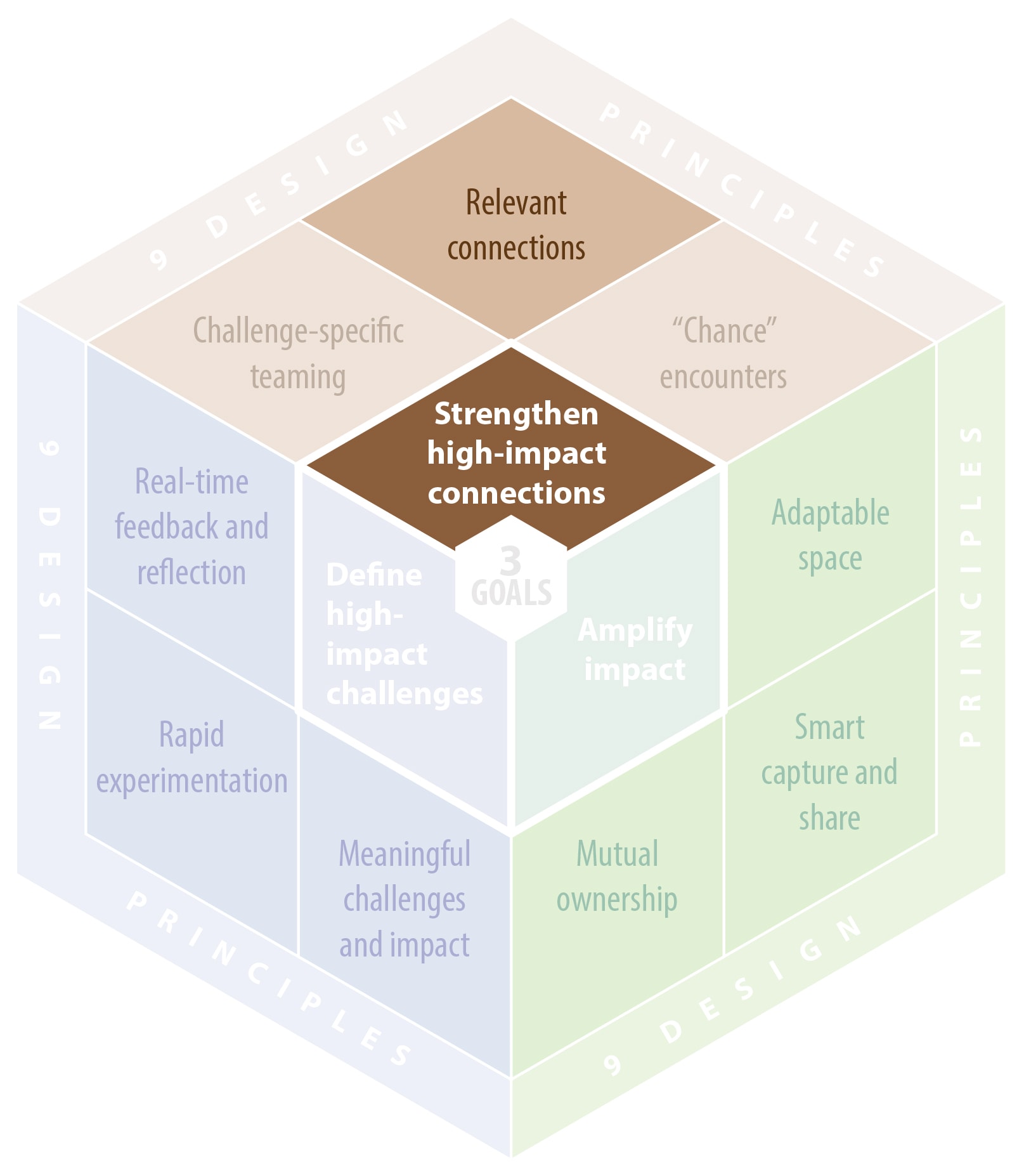 Design principle #5: Relevant connections
Design principle #5: Relevant connections
Environment helps people to more readily find others (within and outside the organization) with relevant expertise to help address performance challenges.
Relevant connections enable workers to solve problems more effectively. Information such as interests, passions, and work history are useful to workers making relevant internal and external connections. Most importantly, historical data, such as past performance on projects, can point to a more honest assessment of expertise, as the evaluation is based on actions rather than claims. In addition to improving problem solving and performance, these connections may lead to future collaboration.
Sharing information about potential connections can be accomplished through reputation profiles. oDesk, the world’s largest online workplace, automatically generates detailed profiles for all of its contractors. These profiles include the contractor’s cumulative rating, as well as a historical record of ratings and hourly wages received for each completed project. If the contractor has taken any tests or certifications, related scores are published. Some profiles even feature screenshots of the contractor’s past work. The platform facilitates relevant connections through reputation profiles that are extremely useful to businesses for assessing and selecting the right contractor for the job at hand. While oDesk is an example of an organization that facilitates connections among third-party participants, companies can also apply oDesk’s practices to become an internal broker for their employees. Using enterprise social software, companies can create platforms and systems to help individuals find each other inside and outside the organization.28
Making connections upfront can also strengthen future collaboration. Motley Fool, an investment advice and media company with nearly 300 employees, employs perhaps the first and only chief collaboration officer in the United States, whose sole job is to ensure employees actively collaborate with one another. In a dynamic company like Motley Fool, being able to identify other experts within the company is a business imperative. Within Jingle, Motley Fool’s enterprise social network powered by SocialText, “Fools,” or employees, can seek others with specific areas of expertise. This system also recommends specific Fools with passions, skills, experience, or interests close to what the user specifies in his or her profile. Leadership’s support of this technology enables Fools to stay connected and find experts within the company to help them solve business challenges. Given the importance of connections, two years ago, the company tied a portion of each individual’s bonus (25 percent)29 to whether he or she could pass a multiple-choice quiz identifying every Motley Fool employee by name.30
Another example of a company generating relevant connections within an ecosystem is SAP Community Network (SCN), which has over 2 million participants collaborating daily, the majority of whom are external to SAP. As participants such as external developers, implementation specialists, and internal SAP product managers join a discussion, their contributions are rated, “liked,” or shared by peers. Over time, users build reputations as their peers award points based on their contributions. This enables users to sort by “Top Participants” on particular topic spaces and judge potential partners based on their online contributions. Some recruiters even ask potential hires for the number of points accumulated on SCN to gauge skill. Eventually, the most well-ranked participants become “SAP Mentors.”31
Moving past the status quo
Today, expertise is difficult to find because competencies are primarily stored within static résumés, panels, and other limiting networks. Few platforms exist to show workers where and how to find expertise. With conversations, projects, and documents moving online, however, organizations have an opportunity to make performance and interactions more transparent and to help workers find experience from all pockets inside and outside their organizations.
The main barrier for many companies is discomfort with this unprecedented level of transparency. Internal politics and external risk to intellectual property (IP) may concern organizations considering enabling free access to performance or project data. New tools are being built in ways that mitigate these risks. Interactive online platforms such as oDesk only allow specialists to see discrete portions of IP. Providing workers with access to professional development organizations or co-working spaces filled only with non-competitors also reduces IP risks.
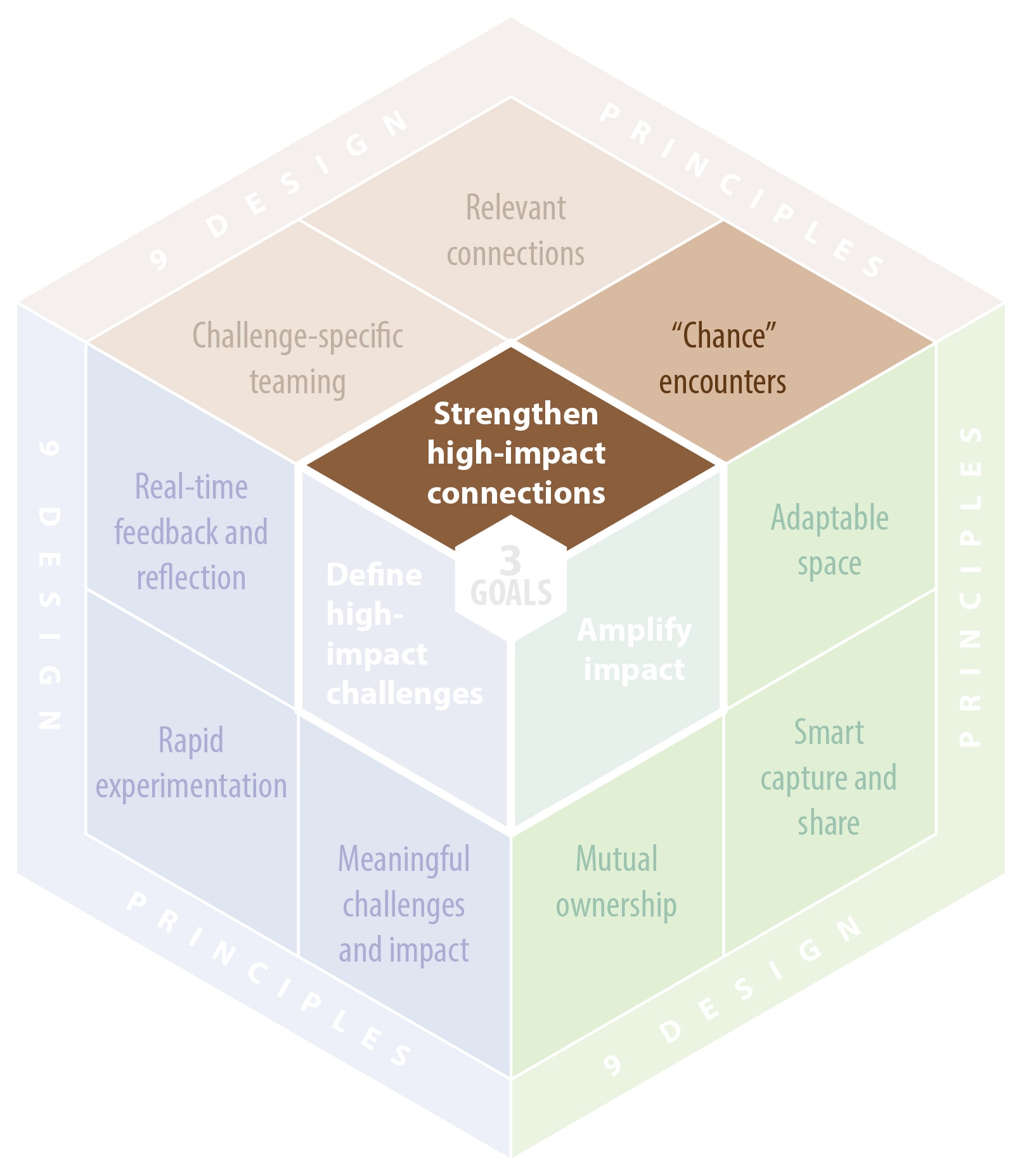 Design principle #6: “Chance” encounters
Design principle #6: “Chance” encounters
Environment is deliberately designed to enhance the probability of serendipitous interactions within the organization and between ecosystem participants.
Being at the right place at the right time is not a new concept. Serendipity is believed to be synonymous with pure luck, but organizations can structure work environments to increase the probability and quality of unplanned encounters. These chance interactions can often lead to ideas and approaches previously unconsidered. To facilitate these types of encounters, companies should structure their physical and virtual environments to enable unexpected connections and to create themes or events that unite people who do not work together day-to-day, while also allowing time and flexibility for individuals to turn chance encounters into performance improvement opportunities.
In traditional organizations, workers often have limited interactions with employees outside of their defined work groups. Additionally, individuals often feel isolated when they work virtually. To address these challenges, some companies structure their physical environment to facilitate unexpected interactions using strategically located common areas. When Airbnb, a peer-to-peer vacation rental company in San Francisco, added a second floor to their office, leaders were concerned that engineers on the lower level would interact less with the customer support team on the level above. To increase chance encounters, the company serves breakfast on one floor and lunch on another to ensure employees mingle at least twice a day. Additionally, communal lunch tables are positioned in continuous rows across the room, encouraging conversations between people who do not normally interact. The continued use of these common areas maintains connections between the two groups.32
Structuring chance encounters is even more important for employees working virtually, as they often feel less connected to the organization. Virtual environments should be created where individuals can “bump into” each other as they would in a cafeteria or at a water cooler. Additionally, virtual environments can easily include customers, partners, and other ecosystem players. For example, the SCN hosts a variety of discussion forums where SAP employees and outside participants can “meet” like-minded individuals.
To further foster chance encounters, companies should unite workers under common themes. Shared themes such as projects, products, and interests can increase the likelihood of valuable outcomes. At one global pharmaceutical company, executives co-locate product teams with very different functional roles as part of a larger workplace transformation strategy. Everyone, from marketers and packaging designers to clinical scientists, sits together, united by one product. Their individual projects are different, but their physical proximity allows for valuable cross-pollination. For example, when the smoking cessation business unit convened to one office, clinicians shared research with marketers connecting smoking with wrinkles, sparking a new marketing campaign called “The Beauty of Quitting.” This marketing campaign has contributed approximately $50 million to the business unit’s revenue.33
Similarly, to unite its employees and strategic partners under a common theme, a market-driven innovation and science company hosts an annual conference called TechCon. During TechCon, teams present new technologies to employees from different business units, as well as external partners, to spark ideas for new applications of these technologies.34 The TechCon conference provides an opportunity for people who do not work together to meet and share ideas.
However, enabling chance meetings is not enough to realize the value of these unexpected connections. Companies should ensure that workers have the flexibility and management permission to act on the opportunities that can emerge from these interactions. Allowing workers to listen, understand, and reflect on these interactions is important for converting a chance encounter into a valuable learning opportunity. For example, software start-up Orbotix, which created the Sphero robotic ball used for gaming, participated in over 20 hackathons in 2012. Hackathon participation is advocated and supported by Orbotix leadership, as the chance encounters created by them often resulted in new product features. For example, during one hackathon, an Orbotix developer paired with a Blackberry developer, and a new Orbotix app for Blackberry users was created in less than 10 hours.35 Allowing professionals to have the flexibility to not only identify, but also pursue, ideas generated from chance encounters can help companies turn ideas into tangible performance improvements.
Moving past the status quo
Most companies view chance encounters as pure luck, something that cannot be managed. Functional departments are typically physically segregated from one another and do not interact on a daily basis. Additionally, technology systems are often disparate, designed to meet the needs of each individual department. Silo-based physical and virtual environments make it hard for people to come together. Further, many managers view chance encounters as unproductive, and companies view interactions with the ecosystem as competitive risk. Fortunately, designing for serendipity, even in its lowest-cost forms (e.g., centralizing a water cooler), is gaining serious traction among industry executives. As the benefits continue to outpace costs, even skeptics will have to find a way to incorporate “luck” into their day-to-day work activities.
Goal 3: Amplify impact
To address the third goal, three design principles detail the infrastructure required to amplify worker effort. Adaptable space provides workers with flexibility, smart capture and share brings germane information to workers, and mutual ownership ties a worker’s sense of ownership to the organization’s success.
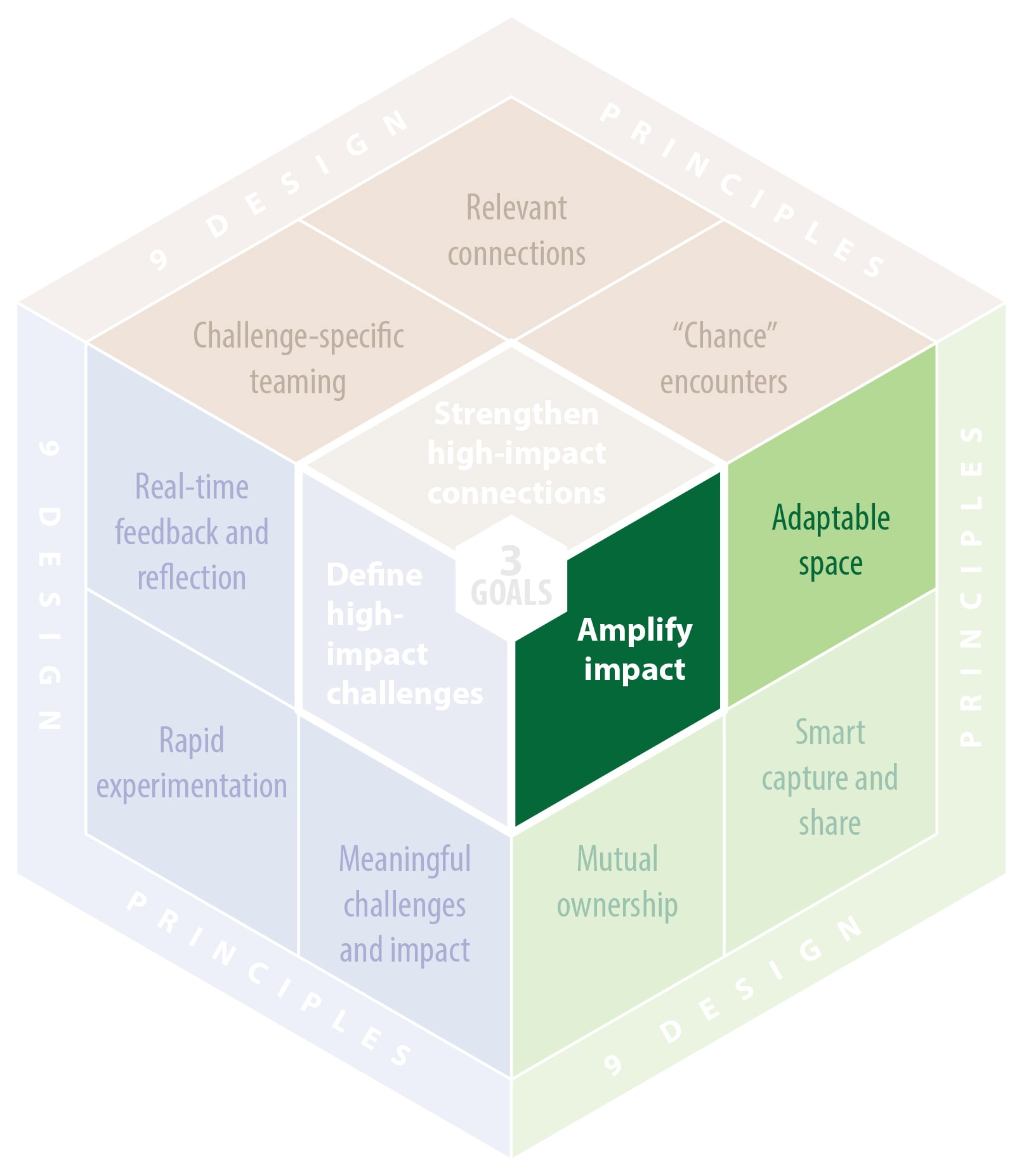 Design principle #7: Adaptable space
Design principle #7: Adaptable space
Environment has a menu of options for spaces and tools, which can be easily tailored to constantly evolve and adapt to employees’ changing needs.
All elements of the work environment should provide workers with the flexibility to create their individualized, optimal context for work. Movable furniture, such as adjustable tables, rolling whiteboards, and portable projector screens, is one way to implement this principle. Modular partitions remove the constraint of static rooms, allowing further adaptation to the changing needs of workers. Workplace designers should also ensure employees have the ability to freely create and adapt their virtual environment to their current projects.
For nearly two decades, SEI (NASDAQ: SEIC), a global provider of outsourced investment solutions, has used adaptable work environments as a competitive advantage. Every desk in SEI’s global offices is on wheels. This makes the environment modular, allowing workers to constantly adapt their settings to the work at hand: When teams need a collaboration space, they roll their desks together. When they need a quiet space, they separate to allow for focused work. SEI’s CEO and chairman, Al West, describes the physical element of desks on wheels as only part of the larger message to employees that flexibility in the work environment is critical for SEI to solve problems more quickly and respond to changing market conditions more effectively.36
Adapting the work space should be simple for the end user—otherwise, customization becomes more time-intensive than workers need or want. To simplify the process of adapting one’s work space, offering a diverse mix of preset options, which can be further customized, may help strike a good balance between customization and convenience. In 2007, a global manufacturer of pharmaceutical products started experimenting with a new office design called “Open Space.” For its East Coast office pilot facility, the company transformed 8,000 square feet into an open office with three different zones—a large “kitchen table” in the center of the room for groups, a series of connected desks surrounding the center table (called the “buzz zone”), and an enclosed quiet room off to the side. The default option is an open setting where workers can collaborate better, thereby improving performance—but rooms for privacy are easily accessible.37 These options offer workers the ability to personalize where they work without the hassle of customization.
Moving past the status quo
Many companies are already experimenting with alternative workplace strategies, such as allowing workers to choose between working in the office or at home. However, using adaptable space, employees will benefit from having several options when they come to the office. Some workers come into the office because they need to work very closely with a small team for a prolonged period of time, while other workers may need to come into the office because their tasks require quick interactions with a large and diverse set of peers. These different scenarios require different work settings to optimize worker effectiveness.
Many companies view offering different physical options as too difficult and expensive. With physical space, redesigning offices commonly requires a sizable investment, and based on today’s ROI-driven investment decisions, it can be difficult to quantify the benefits from such a move. Conversely, while office space redesign seems costly, building adaptable office space can provide financial benefit. For example, open office space redesign efforts and flexible virtual work policies often accompany alternative workplace initiatives. In many cases, companies will incur lower rent expenses as modular desk arrangements often require less floor space than cubicles and, in adaptable work models, more employees may choose to work from home, requiring less overall square footage.
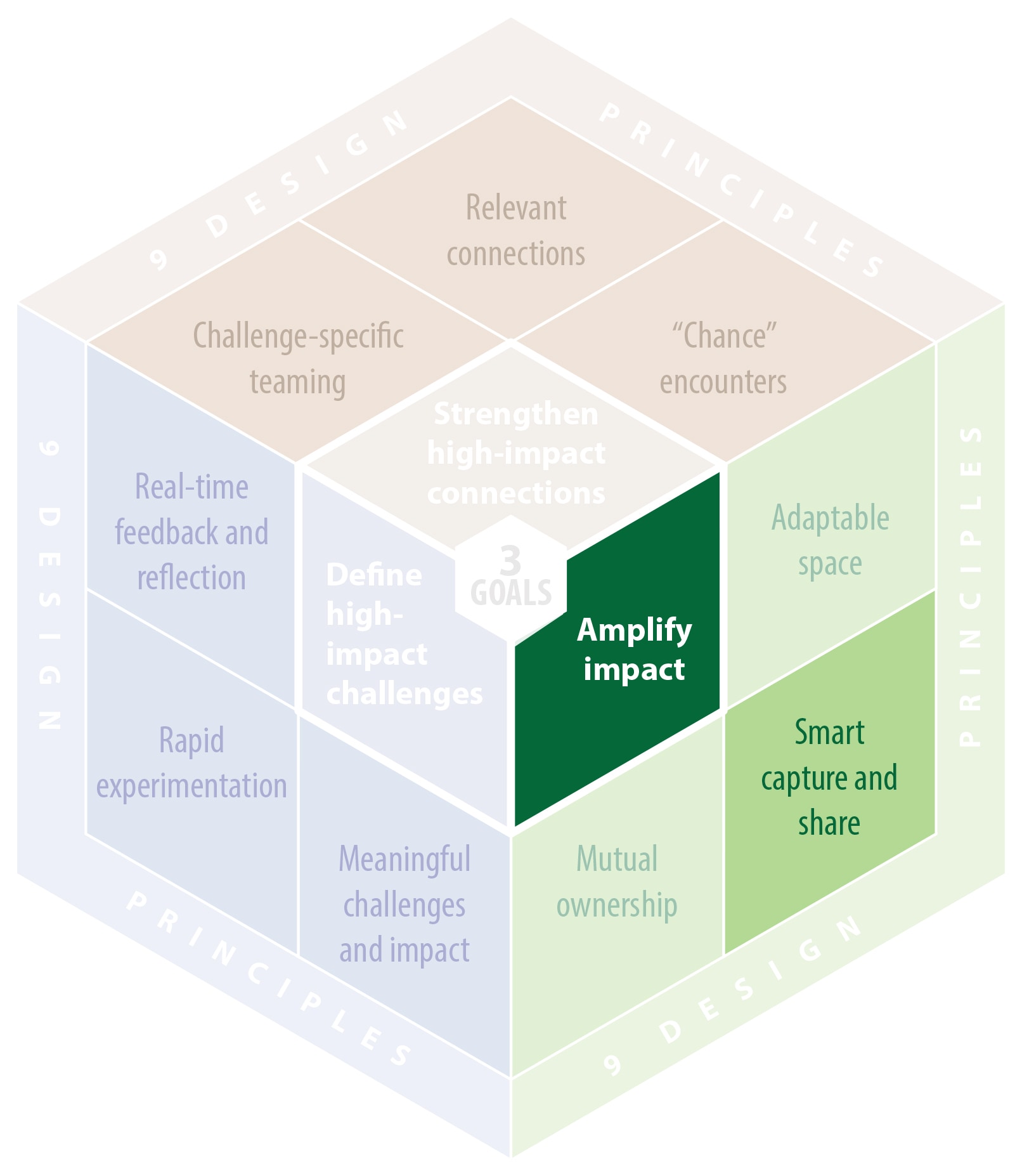 Design principle #8: Smart capture and share
Design principle #8: Smart capture and share
Environment automatically captures, intelligently organizes, and logically shares the interactions and context among participants.
Smart capture and share brings the right information at the right time to those who need it. In any work setting, a great deal of information is exchanged in meetings, conversations, instant messages, and email. Easy access to information in these exchanges can enable peer-to-peer collaboration and provide valuable insights for performance improvement. Work environments should use tools to automatically record, intelligently organize, and make information available to workers so that they can use it to solve problems and improve business processes.
One common tool that demonstrates smart capture and share is online forums. SAP’s SCN uses forums to drive peer-to-peer collaboration and reduce the burden on SAP customer support to address every question or issue that comes its way. For example, an implementation team lead at a manufacturing company who is experiencing unexpected results can pose a question on a forum and receive advice. A few months later, another implementation team at a different company with the same issue can search through forum categories to see if this problem has been previously addressed. Finding the right search result provides guidance to the implementation team. Answers are tagged and rated by users to better help future SAP and external teams solve problems. Rather than spending days internally debating an issue, the implementation team can leverage the forum to achieve more rapid resolution. On SAP’s SCN, responses are typically received in 17 minutes, and over 85 percent of discussions threads across the network are closed out.38
In addition to capturing workers’ virtual activities, physical tracking can also provide valuable information. In “The New Science of Building Great Teams,” Sandy Pentland and his team employed badge-sized sensors to track sociometric data, which showed where and how workers physically interact with one another in the office.39 Coupling this information with individual performance data and digital records, such as emails and chats, can yield telling reputation-based profiles that can then be leveraged to intelligently share information and facilitate connections.
In addition to automatically capturing and intelligently organizing information, the work environment must have a logical way of sharing lessons learned with those who may find them valuable. Similar to how Amazon captures a buyer’s purchasing patterns and uses that to generate product recommendations, a tool that analyzes the content in workers’ emails and makes pattern-based recommendations could be extremely valuable. For example, a system can use automatically captured data such as deliverables, email exchanges, development logs, or other knowledge exchanges to highlight and recommend sources of information that would be applicable to a worker, given the task at hand.
Moving past the status quo
Smart capture and share tools automatically create a record of interactions, eliminating the burdensome process of documentation that is present in today’s knowledge management systems. Because they don’t rely on after-the-fact documentation, smart capture and share systems significantly reduce reporting biases that could diminish the accuracy of recorded information. They are also fully transparent, allowing all users to see how problems were solved, and who solved them. This allows future users to connect with others who can help them solve problems. It also allows for the creation of accurate reputation-based profiles, which are essential to enable relevant connections (design principle #5).
Several obstacles prevent the implementation of smart systems in companies today. First, many executives may not understand the technology, and therefore how it leads to improved performance. Second, few vendors currently offer these services, and developing a system in-house is technically challenging and very expensive. Lastly, employees may feel nervous about being automatically “tracked” at work. As workplace technology continues to evolve and tech-savvy generations enter the work environment, we anticipate some of these obstacles will diminish. In the short term, to enhance acceptance and support, leadership must involve employees in the decisions of what is tracked and the benefit of widespread access to this data. As more tech-savvy Millennials enter the workforce, they will begin expecting the same levels of personalization and automation they see in the apps and services they use in their personal lives to exist in their professional lives. This can create a bottom-up imperative for executives to incorporate this kind of technology into the workplace.
Mayo Clinic
Mayo Clinic (Mayo), a not-for-profit medical practice and medical research group with a reputation for high-quality health care, built an innovative, home-grown smart capture and share patient scheduling system. After instantly synthesizing patient availability, travel time, and other important prerequisites to treatment, the system assigns appropriate physicians and appointments. Once a patient arrives at an appointment, all preceding patient interactions, lab, and exam results are instantly shared with the next clinician in the sequence. With all of this data automatically uploaded and algorithmically processed, the average wait time for an appointment at the Community Pediatric and Adolescent Medicine department decreased from 45 days to 2 days.40 Similar efforts around smart capture and share remain top priorities as the organization continues to expand to new locations.
In addition, maintaining archives of in-depth problem solving is cited as a major benefit. For example, if someone at Mayo is looking at different vendors and deciding which option to select, research and conversations with vendors as well as individual meeting notes and associated outcomes can be made easily accessible. Without such a system, if a similar question surfaces again, the next employee might have to repeat the same process without the pertinent background information. Fortunately, Mayo’s Yammer tool allows for archiving and tagging that reduces these duplicative efforts.
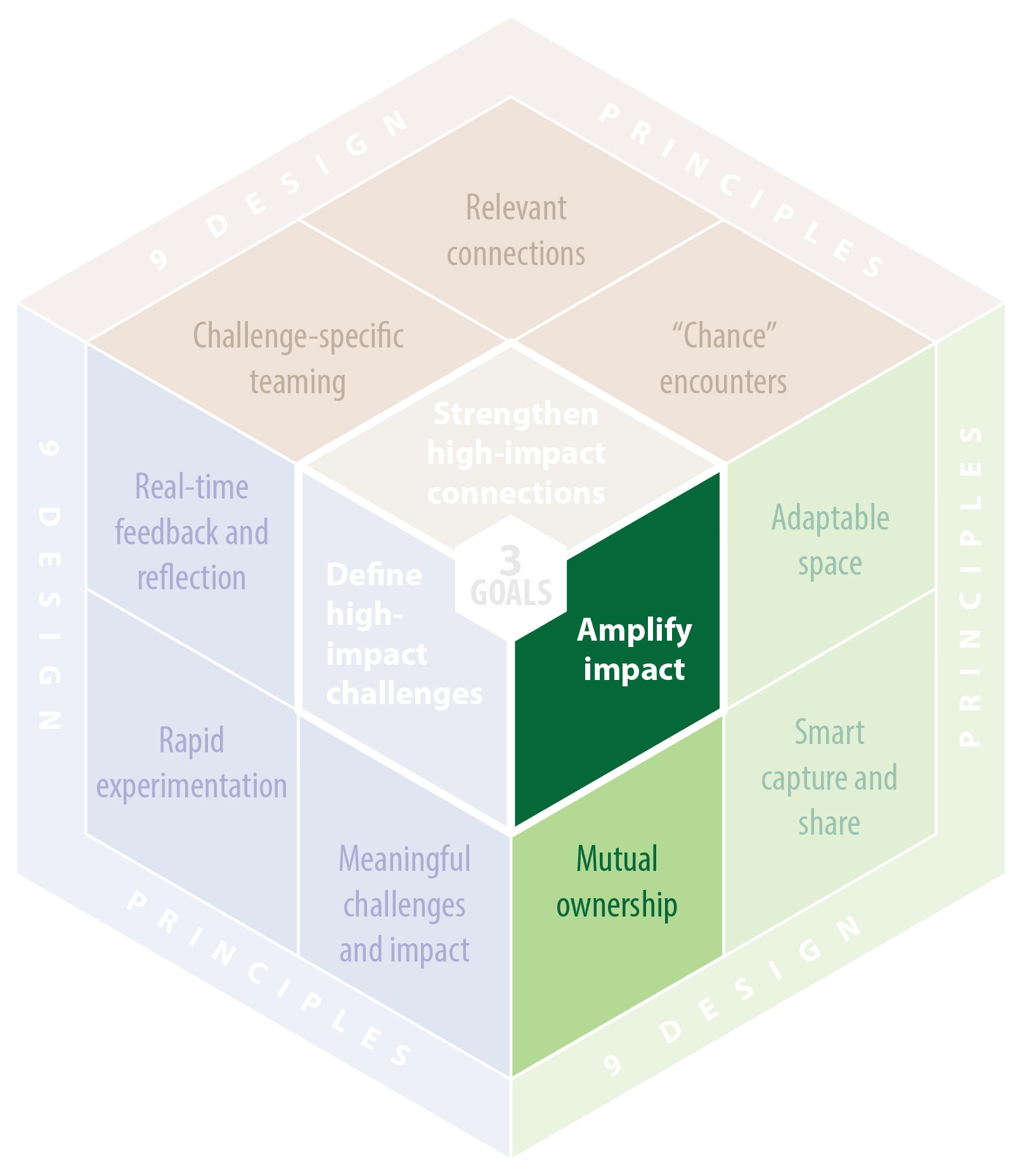 Design principle #9: Mutual ownership
Design principle #9: Mutual ownership
Environment increases the individual’s sense of belonging to the organization and ownership of its success by investing in trust-building behaviors and programs.
Mutual ownership is defined by trust and congruence. Companies that treat employees as owners who are relied upon to act in the company’s best interest will step up to the challenge, as employees feel that their own success is entangled with the company’s success. A deep sense of ownership over the organization’s fate is a powerful motivator for employees to improve performance. Instilling a sense of mutual ownership in employees involves three elements: Work environments should enable employees to shape their own experience, recognize each individual as a “whole person,” and help employees “feel at home” at work.
Detroit Labs, an app development company, trusts employees to make decisions that are typically reserved for management. For example, every single person in the company is consulted during a hiring decision with the opportunity to veto candidates, even if a recruit is heavily advocated for by the company’s founder. Additionally, as an everyday symbol of distributed ownership, everyone with the same job function has the same title (e.g., developer). Employees feel equally valued and are incented to participate and voice their opinions in company decisions.41 Overall, this climate fosters high levels of engagement and ownership, creating a participatory environment where employees are already positioned to support, rather than resist, company decisions or policies.
An employee acts as a “whole person” when he or she can be as authentic at work as at home. This helps to cultivate ownership as employees feel a more genuine connection with the people around them and the values of the organization. Financial investments advisory company Motley Fool encourages employees to bring their “whole selves” to work, in the belief that this mentality is what has allowed them to be at their most profitable during the past 20 years.42 Three years ago, leadership added a new core value called “MOTLEY—Make Foolishness Your Own. Share your core value.” Fools now show their “MOTLEY” on their desks by each choosing the personal concept that fills in the blank. As Sam Cicotello, chief learning officer (CLO), describes her own experience:
As CLO, my MOTLEY is “Encourage”: It’s not worth it for me to come to work every day if I’m not encouraging others. For my CFO, Ollen, however, his MOTLEY is “Be Commercial”: it’s not worth it for him to come to work every day if he’s not watching the bottom line—and what a great thing for our company to have us both. But the magic comes when Ollen and I have to work together. I know that if I have an initiative I need to sell him on, I darn well better appeal to his commercial side, and he knows that I get most excited and engaged when he appeals to my desire to encourage our workforce. It makes interactions faster and more efficient throughout the company.43
This sense of ownership and understanding of one another’s personal values enabled Ollen and Cicotello to decrease their meeting times from 1 hour to 30 minutes because each arrives at the conversation having already interpreted the discussion in terms of the other’s motivations and interests.44
When companies offer programs and perks that benefit employees personally, it makes workers more energized, happier, and motivated to work harder for the company. SAS Institute (SAS), a privately held global leader in analytics software based in Cary, NC, takes great care in providing employees with a comfortable onsite lifestyle so they can focus their attention on maintaining the company’s market leadership position. SAS has experienced record earnings for 37 consecutive years, culminating in $2.8 billion in 2012. Founder and CEO Jim Goodnight leads more than 13,000 employees with annual turnover rates of 2 percent to 3 percent, as compared to the 22 percent industry average.45 So what’s the secret? Goodnight believes employees must be valued above all else and that trust should be infused among all levels of the organization—starting with employees mirroring management’s sense of ownership for the company. SAS employees and their families enjoy a 54,000-square-foot gym with free personal trainers and an Olympic-sized pool.46 There is a free full-service health clinic, extremely affordable quality child care, and “work-life” counselors—all on campus. Employees select their own hours on a 35-hour work week, although employees in actuality choose to work more in response to how secure and taken care of they feel.
These three components—trusting employees to shape their work, recognizing them as “whole persons,” and helping them “feel at home” during work—foster employee respect toward the company and a desire to do all they can to help the company succeed.
To be successful, programs to improve an employee’s sense of organizational belonging and mutual ownership should be consistent with the values of the organization. For these programs to be effective, management must support them from the top down, or they will seem superficial, undermining trust between management and employees. For that reason, organizations can’t merely mimic other companies’ programs; they must innovate and tailor their own programs based on their company’s particular culture.
Moving past the status quo
Most employees today are expected to show up at work as an employee and leave their personal lives, values, hobbies, and interests at home. Many still operate within traditional hierarchies in which managers give orders and employees execute plans. Shifting how employees are viewed and treated will improve everyday morale and productivity; entrusting workers with the company’s success is a clear indication of value perception.
Companies like SAS have varying degrees of success in their use of flamboyant perks to foster a desirable culture and an employee sense of ownership. These perks are a great tool when used correctly, but companies must remember to align these programs with their organizational culture and values, helping employees feel cared for in a meaningful, genuine manner.
Implementing work environment redesign
Design principles tend to be most effective when used concurrently, thereby amplifying their effect. For example, rapid experimentation is most effective when closely coupled with real-time feedback to fuel iterations and continuous improvement. In an effort to engage third-party app developers, AT&T’s developer program carefully designed a work environment that showcases many of the above design principles simultaneously. Additionally, AT&T blends external talent with its own to quickly collaborate and create better products and services for customers, as well as to build its own talent pipeline.
 The design principles in this paper touch on many areas of responsibility within the typical organization, such as human resources, information technology, and real estate. Given the breadth of the holistic approach recommended in this paper, the person leading the implementation of these principles requires the authority to influence decision making across diverse areas of business. The “workplace designer” should be charged with building and cultivating an integrated work environment specifically formed to accelerate business performance. To our knowledge, this role doesn’t exist in companies—yet. While firms should strongly consider creating this position, they can get started on implementing these principles without one.
The design principles in this paper touch on many areas of responsibility within the typical organization, such as human resources, information technology, and real estate. Given the breadth of the holistic approach recommended in this paper, the person leading the implementation of these principles requires the authority to influence decision making across diverse areas of business. The “workplace designer” should be charged with building and cultivating an integrated work environment specifically formed to accelerate business performance. To our knowledge, this role doesn’t exist in companies—yet. While firms should strongly consider creating this position, they can get started on implementing these principles without one.
To begin redesigning the work environment, workplace designers should carefully customize the combination of design principles for their organizations’ specific needs and contexts. While these design principles provide general guidelines, they are not intended to offer the levels of specificity required for successful implementation. Each organization has unique characteristics requiring additional customization. For example, the movable furniture and walls used in the bustling headquarters of one company would not likely be pertinent to the primarily virtual work space of another.
Because of this variation in environment, we propose an experimentation-based, five-step implementation approach:
- Select your focus area
- Crowdsource hypotheses
- Test hypotheses with experiments
- Measure results
- Scale experiments
This approach helps companies test design concepts quickly and then scale them to spread the most effective design approaches throughout the organization.
1. Select focus area
Work environment redesign activities should be conducted with the goal of driving sustained performance improvement. It should be remembered that business metrics relate to each other at various levels of the organization (see figure 3). Selecting focus areas that drive desired outcomes at the front line can lead to improvement in overall company performance. Organizations can use a triage approach to further define focus areas—such as a business unit, department, or team—with highest expected impact given implementation efforts.
To identify these areas, start by examining the highest level of performance, namely financial metrics such as total revenues, costs, or profits, to pinpoint improvement opportunities.
For example, an industry peer comparison of financial results can indicate maintenance cost reduction opportunities. Once the opportunity has been identified, drill down to the operating metrics that most influence those financial metrics. This analysis might uncover that maintenance costs are increasing due to extensive lead times required to fix products. From here, determine the corresponding front-line metrics—perhaps the availability of relevant spare parts to repair products. Upon further investigation, one might conclude that a key obstacle is the level of communication between the maintenance and purchasing departments. Finally, find the work environments that are most relevant to these front-line metrics. If the work environments can be redesigned to address the missing collaboration and communication between the maintenance and purchasing departments, the impact will cascade up to financial metrics that matter to the company, such as maintenance costs.
In addition to areas with the most potential impact, consider targeting “edges” in the company—the areas where new business initiatives are being tested and launched. These edges often have the highest potential for growth and are very receptive to new approaches and practices. As the edges scale rapidly, the design principles implemented there will be enacted quickly and could potentially incite organization-wide application.
2. Crowdsource hypotheses
After identifying front-line issues with the highest potential for improving organizational performance, it is important for companies to decide which combination of design principles are best suited to addressing the issue. For example, the maintenance and purchasing departments in the example above could benefit from chance encounters, rapid experimentation, real-time feedback and reflection, and challenge-specific teaming.
Once targeted design principles are identified, the next step is for companies to define a set of hypotheses that test how each design principle will manifest itself in the context of particular settings. Resisting the temptation to dictate hypotheses from the top, management will find more value from soliciting help from employees at all levels (as they have various perspectives of the business) in order to “crowdsource” the development of hypotheses. Forums and tools such as discussion boards, town halls, and social media can help create these hypotheses. Zappos, a leading online retailer, is an example of a company that believes in involving its employees in organizational decisions. At Zappos, the management team doesn’t view employee “buy-in” of top-down mandates as the winning approach; it instead believes that co-creation generates more traction for new behaviors.47 Involving employees in work environment redesign efforts from the beginning can lead to better implementation results.
3. Test hypotheses
After hypotheses are developed, organizations should structure experiments to test those hypotheses. When defining experiments, there are tradeoffs between structure and obtaining results quickly. While outlining the experiment’s timelines and feedback loops are generally helpful, lengthy instruction manuals and methodologies are almost never necessary. However, it is important to identify a passionate leader who can champion the change. Allow this leader to help craft and personalize these experiments to the specific aspects of his or her business unit, department, or team. Finally, experiments may sometimes require new tools and technologies. However, these requirements need not become a financial obstacle—simple and cheap alternatives usually exist, particularly in untapped areas of the ecosystem. By running experiments with limited budgets, organizations are often able to uncover creative and unconventional solutions.
4. Measure results
Once experiments have been defined, specific quantitative and qualitative metrics can be established to quickly assess the success of these experiments, both during the course of the experiment and after the fact. By connecting front-line metrics to operational metrics and then to overall financial results, the impact of the initiative can be quantified. Where possible, it is important to determine a quantitative baseline and define metrics to be measured throughout the duration of the experiment. By making metrics easy to measure, results can be demonstrated rapidly to help foster enthusiasm from workers and leaders alike. Experiments can then be quickly adjusted based on observed results.
5. Scale experiments
Once metrics demonstrate success, experiments can be scaled throughout the organization, and even the ecosystem, to maximize performance impact. If successful, new practices can spread “virally” throughout the work environment. Once workers and leaders realize the impact of these initiatives, they may be eager to implement these practices in their own areas of responsibility. For example, at DPR Construction, employees often conduct experiments on their own and share results with the organization on SpigIt, an innovation platform; the formal innovation team then chooses to roll out the most promising experiments to the entire organization. One employee created his own sharable SketchUp library of hospital room components, which was rolled out to the entire organization by the innovation team through an executable file.48
Organizations interested in redesigning their work environment with learning and performance improvement goals in mind should approach their work space as a testing ground for new practices. While the design principles suggested in this paper are broad, they are not applicable to all environments in the same way. This experiment-based approach can help companies determine what actions are well suited for their particular contexts and cultures (see figure 4).
An experiment-based approach will quickly show companies what is most effective in their given work environments. As organizations drive performance, they should continue to review lessons learned to identify and implement new experiments that can ultimately transform the business.
 Figure 4. Sample initiatives for each design principle
Figure 4. Sample initiatives for each design principle
Explore the work environment redesign case studies (interactive)
© 2021. See Terms of Use for more information.

